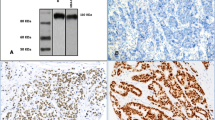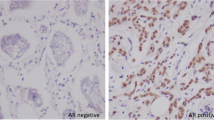Abstract
Background
The androgen receptor (AR) is a commonly-expressed hormone receptor in breast cancer and may be a marker of response to targeted anti-androgen therapy, a particularly attractive option for triple-negative breast cancer (TNBC). Gene expression studies suggest that ARs may distinguish a luminal/AR TNBC subtype from stem cell-like subtypes. TNBC frequency is two to three times higher in African American and African breast cancers compared with White American and European breast cancers, yet little is known regarding TNBC subtypes in high-frequency African-ancestry populations. We evaluated ARs and the mammary stem cell marker aldehyde dehydrogenase 1 (ALDH1) among breast cancers from Ghana, Africa.
Methods
Overall, 147 formalin-fixed, paraffin-embedded invasive breast cancers from the Komfo Anoyke Teaching Hospital in Ghana were studied at the University of Michigan, and analyzed immunohistochemically for estrogen receptor (ER), progesterone receptor (PR), HER2/neu, ALDH1, and AR expression.
Results
The median age of patients was 45 years. Only 31 cases (21 %) were ER-positive, and 14 (10 %) were HER2-positive; 89 (61 %) were TNBCs. For the entire group, 44 % were AR-positive and 45 % were ALDH1-positive. ER/PR-positive tumors were more likely to be AR-positive compared with ER/PR-negative tumors (87 vs. 26 %; p < 0.0001), but there was no association between ALDH1 and AR expression. Among the TNBC cases, 45 % were ALDH1-positive and 24 % were AR-positive. ALDH1 positivity was associated with AR positivity within the subset of TNBC (36 vs. 14 %; p = 0.019).
Conclusion
We confirmed other studies showing a high frequency of TNBC in Africa. Surprisingly, ALDH1 was found to correlate with AR expression among TNBC, suggesting that novel TNBC subtypes may exist among populations with African ancestry.
Similar content being viewed by others
References
Brenton JD, Carey LA, Ahmed AA, Caldas C. Molecular classification and molecular forecasting of breast cancer: ready for clinical application? J Clin Oncol. 2005;23(29):7350-7360.
Perou CM, Sorlie T, Eisen MB, et al. Molecular portraits of human breast tumours. Nature. 2000;406(6797):747-752.
Alluri P, Newman LA. Basal-like and triple-negative breast cancers: searching for positives among many negatives. Surg Oncol Clin N Am. 2014;23(3):567-577.
Hudis CA, Gianni L. Triple-negative breast cancer: an unmet medical need. Oncologist. 2011;16 Suppl 1:1-11.
Lehmann BD, Bauer JA, Chen X, et al. Identification of human triple-negative breast cancer subtypes and preclinical models for selection of targeted therapies. J Clin Invest. 2011;121(7):2750–67.
Chen X, Li J, Gray WH, et al. TNBC type: a subtyping tool for triple-negative breast cancer. Cancer Inform. 2012;11:147-156.
Masuda H, Baggerly KA, Wang Y, et al. Differential response to neoadjuvant chemotherapy among 7 triple-negative breast cancer molecular subtypes. Clin Cancer Res. 2013;19(19):5533-5540.
Shah PD, Gucalp A, Traina TA. The role of the androgen receptor in triple-negative breast cancer. Womens Health (Lond Engl). 2013;9(4):351-360.
McNamara KM, Yoda T, Takagi K, Miki Y, Suzuki T, Sasano H. Androgen receptor in triple negative breast cancer. J Steroid Biochem Mol Biol. 2013;133:66-76.
McGhan LJ, McCullough AE, Protheroe CA, et al. Androgen receptor-positive triple negative breast cancer: a unique breast cancer subtype. Ann Surg Oncol. 2014;21(2):361–7.
Gucalp A, Tolaney S, Isakoff SJ, et al. Phase II trial of bicalutamide in patients with androgen receptor-positive, estrogen receptor-negative metastatic Breast Cancer. Clin Cancer Res. 2013;19(19):5505-5512.
Gucalp A, Traina TA. Triple-negative breast cancer: role of the androgen receptor. Cancer J. 2010;16(1):62-65.
Gucalp A, Traina TA. Triple-negative breast cancer: adjuvant therapeutic options. Chemother Res Pract. 2011;2011:696208.
Wolff AC, Hammond ME, Hicks DG, et al. Recommendations for human epidermal growth factor receptor 2 testing in breast cancer: American Society of Clinical Oncology/College of American Pathologists clinical practice guideline update. J Clin Oncol. 2013;31(31):3997-4013.
Hammond ME, Hayes DF, Dowsett M, et al. American Society of Clinical Oncology/College Of American Pathologists guideline recommendations for immunohistochemical testing of estrogen and progesterone receptors in breast cancer. J Clin Oncol. 2010;28(16):2784-2795.
von Wahlde MK, Hulsewig C, Ruckert C, Götte M, Kiesel L, Bernemann C. The anti-androgen drug dutasteride renders triple negative breast cancer cells more sensitive to chemotherapy via inhibition of HIF-1alpha-/VEGF-signaling. Gynecol Endocrinol. 2015;31(2):160–4.
Ginestier C, Hur MH, Charafe-Jauffret E, et al. ALDH1 is a marker of normal and malignant human mammary stem cells and a predictor of poor clinical outcome. Cell Stem Cell. 2007;1(5):555-567.
McNamara KM, Yoda T, Miki Y, et al. Androgenic pathway in triple negative invasive ductal tumors: its correlation with tumor cell proliferation. Cancer Sci. 2013;104(5):639-646.
Thike AA, Yong-Zheng Chong L, Cheok PY, et al. Loss of androgen receptor expression predicts early recurrence in triple-negative and basal-like breast cancer. Mod Pathol. 2014;27(3):352–60.
Stark A, Kleer CG, Martin I, et al. African ancestry and higher prevalence of triple-negative breast cancer: findings from an international study. Cancer. 2010;116(21):4926-4932.
Schwartz T, Stark A, Pang J, et al. Expression of aldehyde dehydrogenase 1 as a marker of mammary stem cells in benign and malignant breast lesions of Ghanaian women. Cancer. 2013;119(3):488-494.
Vera-Badillo FE, Templeton AJ, de Gouveia P, et al. Androgen receptor expression and outcomes in early breast cancer: a systematic review and meta-analysis. J Natl Cancer Inst. 2014;106(1):djt319.
Author information
Authors and Affiliations
Corresponding author
Additional information
As senior authors, Celina Kleer and Lisa Newman have contributed equally to this research and associated manuscript.
Rights and permissions
About this article
Cite this article
Proctor, E., Kidwell, K.M., Jiagge, E. et al. Characterizing Breast Cancer in a Population with Increased Prevalence of Triple-Negative Breast Cancer: Androgen Receptor and ALDH1 Expression in Ghanaian Women. Ann Surg Oncol 22, 3831–3835 (2015). https://doi.org/10.1245/s10434-015-4455-x
Received:
Published:
Issue Date:
DOI: https://doi.org/10.1245/s10434-015-4455-x




